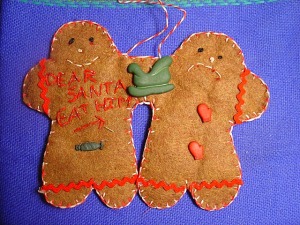 I went to a church rummage/holiday bazaar today and came across a hand shaped gingerbread style bread decorated simply with raisin eyes and some crushed sugar. When I asked what they were, the smiling lady, in her heavy Swiss accent, informed me that today was St. Nicholas’ Day and these were “Grattimannenm”. I bought one to take home for my hubby and me for tea time. I knew of St. Nicholas’ Day being celebrated in the Netherlands because I used to have a penfriend there who always sent me presents on St. Nicholas’ Day.
I went to a church rummage/holiday bazaar today and came across a hand shaped gingerbread style bread decorated simply with raisin eyes and some crushed sugar. When I asked what they were, the smiling lady, in her heavy Swiss accent, informed me that today was St. Nicholas’ Day and these were “Grattimannenm”. I bought one to take home for my hubby and me for tea time. I knew of St. Nicholas’ Day being celebrated in the Netherlands because I used to have a penfriend there who always sent me presents on St. Nicholas’ Day.
Being me, I had to look it up(unfortunately, I didn’t take a picture of it before we ate it…thus the silly photo above…) Grattimannenm , Grittibanzernm, Stutenkerl, Weckmann,Baselmann and Nikolaus are all names for a tradition for St. Martins Day(November 11) and St. Nicholas Day(December 6). They traditionally have raisin eyes, caps and fancy vests made from the bread dough.
” Made from a sweet yeast dough formed by hand into the shape of a plump, approx. five inch (12 cm) tall, “bread man”, Weckmaenner often have eyes and a mouth made with raisins, buttons made from raisins, slices of almonds or dried cranberries, and, although sometimes the figures are miniature works of art, they are usually more like a simple rather chubby gingerbread man.
A custom that began in the early days of the Christian church when blessed but not consecrated bread was given to those who did not, or could not, take part in Eucharist, over time it became known as ‘image bread’, Gebildbrot, because the dough was made into a shape that fitted to the holiday or celebration.
In Germany the Bread Man first became a popular treat just during the festive season, and it was called a Nikolaus for St. Nicholas Day on December 6, but the tradition now begins on November 11th, for St. Martin’s Day. “(http://www.bellaonline.com/articles/art26434.asp)
Grattim comes from the High German word “gratsch beinigm” meaning stick man. It is thought that Grattim were made to represent Nichola’s helper Schmutzlim and the German Kneckt Ruprecht servant of St. Nicholas.
Edible animal and human figurines apparently goes back to the ancient celebrations in which they were used as the substitutes for live sacrifices.
Gingerbread in its’ early form can be traced back to the ancient Greeks and Egyptians who used it for ceremonial purposes. In the 11th century it made it’s appearance in Europe when the crusaders brought the spice Ginger back from the Middle East. Gingerbread is considered an art form in Nuremberg, Ulm and Pulsnitz in Germany, Torun in Poland, Tula in Russia, Pest in Hungary, Pardubice and Prague in the Czech Republic and Lyon in France..where gingerbread baking guilds were sanctioned by the government starting in the Middle Ages.
The bread man I had today was very simple…didn’t have the hat, vest and pipe described here…he simply had two raisin eyes and a sprinkling of green crystal sugar. I found two recipes online and the Weckmann recipe with the lemon sounds like what this one was. http://www.bellaonline.com/articles/art26434.asp
The second recipe seems plainer…so if you don’t like lemon flavoring, you might like this one. http://www.csmonitor.com/1982/1112/111232.html
I ate mine plain but my husband put butter and jam on his. Since I don’t eat much sugar anymore, this may be a great alternative to the richer gingerbread man recipe…according to the bellaonline recipe, it makes 10…I’ll let you know if I attempt it…wonder if I could freeze them?
Happy St. Nicholas’ Day!
til next time…Eva